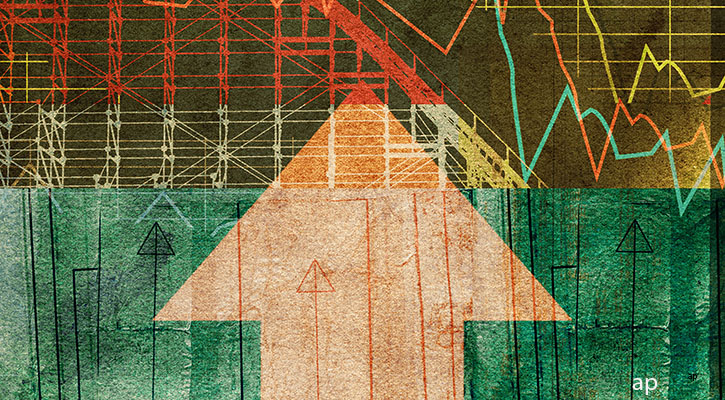Mitä tapahtuu maailmantaloudessa ja finanssimarkkinoilla vuonna 2011? Tässä artikkelissa Yhdysvaltain kansantalouden tapahtumia ennustaa Morningstarin taloustutkimuksen johtaja Robert Johnson, CFA. Artikkeli on aiemmin julkaistu sisarsivustollamme Morningstar.co.uk.
I have long talked of the virtuous cycle of an economic recovery, where increased consumer spending leads to more production that in turn leads to more employment and more income that leads to more spending. Once the process is set in motion, it is indeed hard to break.
Although we have seen that cycle begin, I believe the economy is now at a tipping point, about to move into a stronger, more sustainable recovery. Until the third quarter of 2010, consumer spending had been increasing at a steady but anaemic 2% pace, which was not enough to really get the virtuous cycle going with gusto. The cycle was slowed due to remarkable productivity gains during the recession and consumers propensity to spend a lot of their extra dollars on foreign goods. However, things began to change in the third quarter of 2010 as consumer spending accelerated to almost 3%, and early reports suggest it could accelerate to as much 4% in the fourth quarter driven by the strongest holiday season since 2005. And, recent trade data suggest that more of those dollars are being spent on US products as well.
A lot of firms probably could limp along at 2% consumption growth without having to hire a lot of new people, given a typical 1% productivity increase and the fact that some of that demand was satisfied by overseas factories. However, with 3% to 4% growth, better hiring rates are in the cards. Higher employment levels and higher asset prices, combined with a substantial (though largely unrecognised) improvement in consumer financial positions and lower payroll taxes should continue to drive the consumer forward in 2011.
GDP Could Accelerate to 3.5%-4.0% in 2011; Unemployment Could Fall to Under 9%
A strong consumer is the backdrop for my forecast for 2011 GDP growth of 3.5% to 4%, versus just under 3% for 2010. In 2011, the economy will derive more of its growth from revitalised consumer and business spending than from the inventory adjustments that were such an important part of 2010's results.
The lifting of many hiring bans and salary freezes at the turn of the year combined with a great holiday season and better sentiment could drive job growth of 200,000 to 300,000 people by the middle of 2011. This job growth rate combined with a modestly lower participation rate could drive unemployment under 9% by the middle of 2011.
I believe that continued growth in emerging markets, a stronger US economy, and rising commodity prices will drive inflation up by 2% or more, versus about 1% in 2010. A stronger U.S economy combined with modestly higher US interest rates in 2011 are also the backdrop for a stable to modestly stronger dollar, despite some legitimate questions about very liberal US fiscal and monetary policies. The stronger economy will also be responsible for higher interest rates in 2011, despite the Fed's best efforts to keep rates down.
It Is Not All a Bed of Roses, Either
You can count me as an unabashed bull on the economy, but we aren't without risks.
Europe has yet to come to grips with its long-term debt issues, although policymakers have put a major band-aid on short-term issues. China continues to grapple with inflation that is considerably higher than the government would like to see. That in turn continues to flame fears that China will take steps to slow growth in one of the economies that has been a major engine for the worldwide recovery.
Longer-term interest rates in the United States are sharply higher over the last couple of months, with the 10-year bond now almost a percentage point above its low this fall; it now stands at just under 3.4%. This won't do wonders for a housing market that, while struggling, seems to have hit bottom.
Merger Activity Indicates Businesses Are Refocused on Growth
Our equity sector teams are also becoming at least slightly more bullish about 2011 on a fundamental basis, though most teams believe their stocks are close to fairly valued today, with a lot of good news already priced into the shares.
In terms of fundamentals, there are a few common threads among the teams. First, merger-and-acquisition activity remains strong across every one of our sectors. There are a variety of drivers, but the root cause of most of the activity seems to be an attempt to accelerate growth. Whether or not these deals truly add value to shareholders remains an open question, but the good news is that corporations at least appear interested in growth again and not just surviving, as was the case a year or two ago.
Emerging Markets Aiding Worldwide Growth
Emerging markets are another common theme for both 2010 and 2011. Whether its factory capital equipment or fast food, emerging markets remain key growth areas as those countries boast growth rates that are two or three times higher than those found in developed economies. A growing middle class further cements the opportunity in these markets.
However, even a modest slowing of growth rates in China and elsewhere tends to move worldwide markets dramatically. Some of the worst days in the US stock market this year happened when China's hot economy had showed signs of slowing. Hopefully, a stronger US consumer will take some of the pressure off the fixation on growth in emerging markets.
Consumers Can't Put Off Spending ForeverWhile our equity research teams largely still see a cautious and frugal consumer in 2010, most expect to see a more resilient consumer in 2011. Some of that optimism is based on the fact that consumers have delayed a lot of non-critical spending during the recession that they can no longer put off. Even our health-care team noticed a marked slowing in health-care spending this recession, as consumers deferred procedures. That same team is now seeing an improvement in the rate of even some elective surgeries. In the industrials arena, our auto analyst notes that it is becoming more and more difficult to put band-aids on older cars and that auto sales and production are more likely to perk up again in 2011.
Some Sectors Poised for Better Results with Improved Employment Data
The better employment data I am projecting should begin to help out the consumer, too. Consumer spending that is more directly related to employment has languished during this recovery. While sit-down, casual restaurants have shown some nice improvements, quick-service restaurants have suffered as the number of factory and office workers dashing out for lunch has failed to increase by much. Likewise poor employment has left fewer consumers with access to health insurance, putting a damper on health-care spending. Both should see an uptick as employment turns around.
Businesses Have Underinvested, Too
The severity of this recession and questions about the sustainability of the recovery had a huge negative effect on business investment spending. Our industrial team outlook highlights just how drastically business spending was cut this recession and has yet to make a full recovery. Based on typical ratios of spending to GDP, the team expects a substantial improvement in capital spending over the years ahead.
Likewise our technology team is seeing dramatic increases in business capital spending, especially for software. However, some of the team's enthusiasm is tempered by slowing government spending, especially in Europe.
High Valuations and Thirst for Growth Will Drive Business Investment and Employment
I surmise that businesses will be much more focused on growth in 2011. While far less prevalent than in 2009, cost-cutting and productivity were still very important earnings drivers in 2010. However, a lot of those easy cost savings are gone. Strong emerging markets are also likely to drive important commodity inputs upward in 2011, further pressuring margins. Therefore, to grow earnings in 2011 and beyond, many industries will need to seek improved revenue growth. At the type of valuation multiples placed on major publicly traded firms, investors aren't likely to sit patiently on their hands waiting for growth to slowly emerge. That is partly why we are seeing the boom in mergers and acquisitions. As the prices of the most likely acquisition candidates continue to move into nosebleed territory, I believe that increased corporate growth will have to be earned the hard way, through increased investment and increased employment in 2011.
US Construction Won't Boost 2011 Much; Off to the Races in 2012?
Our housing team continues to believe that housing starts will have a modest increase in 2011 to the 650,000 to 750,000 unit level. This is up from about 590,000 units in 2010 but well below the annual high of 2.2 million units and natural population-driven needs of about 1.5 million units. In my opinion, we will have a dramatic surge in housing construction over the next five years as production rates rise to match natural demand. However, given that employment data has only recently begun to get better and that lending standards and appraisals remain incredibly stringent, I don't think that 2011 will be the year of the housing boom.
Recovery Progresses Slowly and in Relatively Balanced Manner
As is typical, different sectors have driven the GDP growth each quarter of the five quarters that we have been in recovery mode. Consumer spending and dramatically slowing imports were big pluses for GDP before the recovery officially began in the third quarter of 2009. The first quarter of the official recovery was driven by consumer goods and exports. Then inventory restocking and business investment spending kicked in during later quarters, boosting GDP growth.
Looking back at the entirety of the recovery, a lot of the key categories have now made about equal contributions to the recovery, as indicated in the table below (for each time period, the two best categories are highlighted). Consumer spending, business spending (excluding structures), and inventories have made relatively equal contributions to GDP growth. Exports have been the real over-achiever. Those contemplating protectionist moves should consider the leading role that exports have played during this recovery. Construction, both residential and commercial, has been a small minus this recovery while government spending has been a very small positive.
Now the Consumer Takes the Lead
I suspect that fourth-quarter consumer expenditures, which have been building steadily throughout the recovery, will explode to the upside. Consumer spending that has been expanding at a 2% annualised rate for most of the recovery could grow as much as 4% in the fourth quarter based on strong monthly retail sales reports. Though things could back off some in the first quarter, the 2% reduction in payroll taxes will put more money in consumers' pockets that is highly likely to be spent, aiding consumer spending throughout 2011.
Debt May Not Be as Big an Issue as Some Surmise
A greater willingness for consumers to spend was the key reason that so many prior GDP forecasts of 1% growth or less for the second half were so off the mark. (Actual second-half 2010 growth is highly likely to exceed 3%.) Many pundits missed how damaging imports had been on second-quarter results and extrapolated that disastrous data for the rest of the year, failing to notice the steady-Eddie spending by many consumers.
Better consumer incomes and employment certainly didn't hurt, either. And while many analysts continue to fret about consumer debt levels, ratios of various fixed payments--including mortgages, car payments, rent payments, and credit card payments--dropped from 18.9% of income at its peak to 16.8% in the third quarter of 2010. In fact, that ratio is now below the average of the last 30 years and is back to levels last seen in the mid-1990s.
Putting It All Together, the Consumer Is King
Unlike 2010, the consumer will be the economic driver in 2011 as inventory growth slows dramatically. Business spending and exports will do their part, but they will not have as much influence as they did in 2010. Construction will provide little good or bad for the economy in 2011. Imports, which were so strong in 2010, remain a bit of a wildcard in my overall forecast.
















